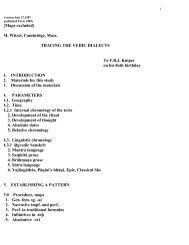references - people.fas.harvard.edu - Harvard University
references - people.fas.harvard.edu - Harvard University
references - people.fas.harvard.edu - Harvard University
Create successful ePaper yourself
Turn your PDF publications into a flip-book with our unique Google optimized e-Paper software.
eligion. And the newcomer to any society or community,<br />
especially if cultured, would be considered<br />
as mimicking local traditions as he tried, usually in<br />
vain, to assimilate. The idea that conversion, even<br />
by the intellectual elite, would convince Christians<br />
of the Jews’ desire to fully assimilate becomes increasingly<br />
spurious as the century marched on, and<br />
the systematic rise of anti-Semitism had become<br />
so pervasive that one is obliged either to condemn<br />
Abraham Mendelssohn for having committed either<br />
a spiritual transgression or to pity this “tragic fi gure,”<br />
as Eric Werner has called him, 22 for what had<br />
probably been an extremely naive miscalculation.<br />
Well before and well beyond Wagner’s infamous<br />
diatribe, Das Judenthum in der Musik (“Jewry in<br />
Music,” of 1850), one reads unconscionably derisive<br />
pamphlets by countless, rabid anti-Semites<br />
across Europe on the inability of the Jew to truly<br />
integrate socially and, artistically, to be independently<br />
creative.<br />
Sociologists Julia Kristeva and Frantz Fanon<br />
have posited, respectively, that cultural identifi cation<br />
through assimilation, if successful, is “poised<br />
on the brink of a ‘loss of identity’ and ‘cultural<br />
undecidability’.” 23 And perhaps no better example<br />
of this exists than that of Felix Mendelssohn. For<br />
within the concept of the nation, nationhood or<br />
nationality, “nation” is obviously connected with<br />
“native.” To paraphrase Homi Bhabha: <strong>people</strong> are<br />
born into relationships which are typically settled<br />
in a place. This form of primary and “placeable”<br />
bonding is of quite fundamental human and natural<br />
importance. 24 Such reasoning also defi nes the<br />
historically progressive levels of attachment of the<br />
Mendelssohn family to Germany, and corresponds<br />
to the bulk of the Jewish population of Germany<br />
(and Europe) unwilling or incapable of reading the<br />
handwritings on Hitler’s walls and emigrating en<br />
masse. 25 For as Leon Botstein maintains:<br />
22 See Werner, 38.<br />
23 Cited in Homi Bhabha, Nation and Narration,<br />
New York and London: Routledge, 1990, 304.<br />
24 Ibid., 45.<br />
25 Cf. Hertz, 15; also, n. 40.<br />
ces papers - open forum # 6, 2011<br />
Mendelssohn was the most widely<br />
recognized exemplar of the presumed<br />
folly of a faith in German-Jewish<br />
“symbiosis”… that the German-<br />
Jewish community had been living a<br />
dangerous lie from the 1790s on.” 26<br />
The Symphony<br />
The psychological implications of the “Reformation”<br />
Symphony’s emotional landscape are<br />
compelling and, if a hermeneutic perspective should<br />
gain validity, this reassessment may shed light on<br />
Mendelssohn’s inner life, social conscience, and<br />
philosophical reasoning.<br />
The Symphony itself is cyclic and therefore<br />
symbolic of oneness, of eternity, and of the Judeo-<br />
Christian belief in the eternal soul. 27 “A compact<br />
Beethoven ‘Ninth’”, some have lamely called it, due<br />
to a weak thematic link predicated on the perfect intervals:<br />
26 Leon Botstein, “Mendelssohn and the Jews,” in<br />
The Musical Quarterly 82 (Spring 1998), 216.<br />
27 Cf. Mercea Eliade, The Myth of the Eternal Return,<br />
Princeton: Princeton <strong>University</strong> Press, 2005, 124; see also<br />
Ecclesiastes 12:7; Genesis 2:7; and 1 Corinthians 15:45.<br />
7

















